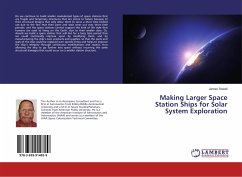
Making Larger Space Station Ships for Solar System Exploration
Versandkostenfrei!
Versandfertig in 6-10 Tagen
24,99 €
inkl. MwSt.

PAYBACK Punkte
12 °P sammeln!
Do we continue to build smaller modularized types of space stations that are fragile and temporary structures that are prone to failure because of their structural designs that only allow them to serve a short time limited use due to the fact that their parts and seals wear out over short time periods, and the space stations cannot support the kind of life style that humans are used to living on the Earth, due to their smaller sizes. Or, should we build a space station that will last for a long time period that we could continually improve upon by modifying them, and by manufacturing the ship'...
Do we continue to build smaller modularized types of space stations that are fragile and temporary structures that are prone to failure because of their structural designs that only allow them to serve a short time limited use due to the fact that their parts and seals wear out over short time periods, and the space stations cannot support the kind of life style that humans are used to living on the Earth, due to their smaller sizes. Or, should we build a space station that will last for a long time period that we could continually improve upon by modifying them, and by manufacturing the ship's own products and supplies, so that the parts and seals of the ship could be replaced over specific times and helps to improve the ship's integrity through continuous modifications and repairs, thus allowing the ship to go further into space without incurring the same structural damages that could occur on a smaller station structure.












